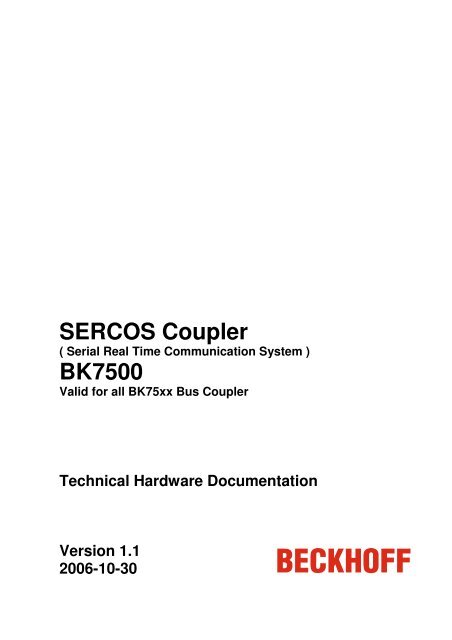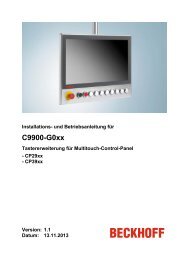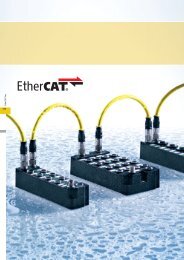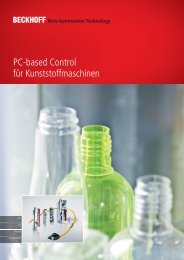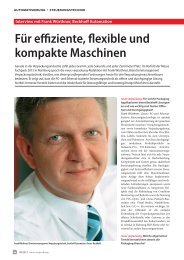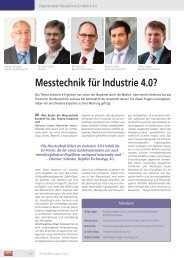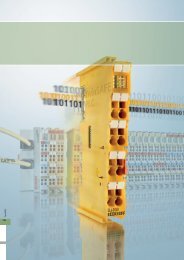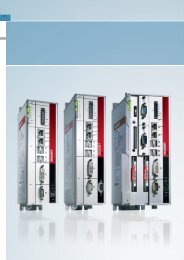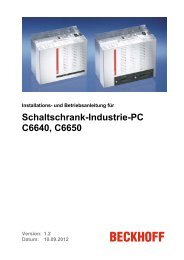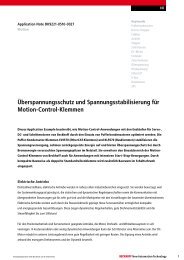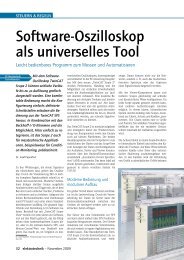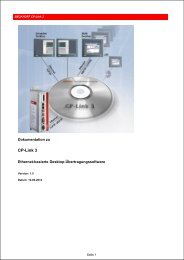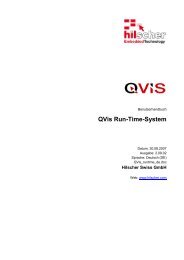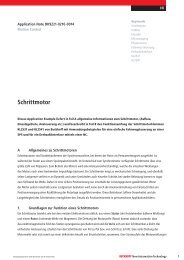SERCOS Coupler BK7500 - download - Beckhoff
SERCOS Coupler BK7500 - download - Beckhoff
SERCOS Coupler BK7500 - download - Beckhoff
Create successful ePaper yourself
Turn your PDF publications into a flip-book with our unique Google optimized e-Paper software.
<strong>SERCOS</strong> <strong>Coupler</strong><br />
( Serial Real Time Communication System )<br />
<strong>BK7500</strong><br />
Valid for all BK75xx Bus <strong>Coupler</strong><br />
Technical Hardware Documentation<br />
Version 1.1<br />
2006-10-30
Contents<br />
Contents<br />
1. Foreword 3<br />
Notes on the documentation 3<br />
Liability Conditions 3<br />
Delivery conditions 3<br />
Copyright 3<br />
Safety Instructions 4<br />
State at Delivery 4<br />
Description of safety symbols 4<br />
2. Basic information 5<br />
The <strong>Beckhoff</strong> bus terminal system 5<br />
The interfaces 7<br />
Power supply 7<br />
Power supply to the power contacts 7<br />
Power contacts 7<br />
Fieldbus connection 8<br />
Configuration interface 8<br />
K-bus contacts 8<br />
Supply isolation 8<br />
The operating modes of the bus coupler 9<br />
Mechanical construction and mounting 11<br />
Electrical data 13<br />
The peripheral data in the process image 14<br />
Starting operation and diagnostics 17<br />
Terminal bus error 18<br />
Fieldbus error 18<br />
Setting the Transmission Rate 19<br />
Setting the Cable Length 19<br />
Setting the Station Address 20<br />
3. <strong>SERCOS</strong> interface <strong>Coupler</strong> <strong>BK7500</strong> 21<br />
Introduction to the <strong>SERCOS</strong> Interface System 21<br />
The I/O Data Channel 23<br />
The transfer medium: plugs and cables 27<br />
4. Appendix 28<br />
Example: composition of a process image in the Bus <strong>Coupler</strong> 28<br />
The hardware configuration: 28<br />
Configuration of the <strong>SERCOS</strong> master 29<br />
5. Index 31<br />
6. Support and Service 32<br />
<strong>Beckhoff</strong>'s branch offices and representatives 32<br />
<strong>Beckhoff</strong> Headquarters 32<br />
2 Buskoppler <strong>BK7500</strong>
Foreword<br />
Notes on the documentation<br />
Foreword<br />
This description is only intended for the use of trained specialists in control and automation engineering<br />
who are familiar with the applicable national standards. It is essential that the following notes and<br />
explanations are followed when installing and commissioning these components.<br />
Liability Conditions<br />
The responsible staff must ensure that the application or use of the products described satisfy all the<br />
requirements for safety, including all the relevant laws, regulations, guidelines and standards.<br />
The documentation has been prepared with care. The products described are, however, constantly under<br />
development. For that reason the documentation is not in every case checked for consistency with<br />
performance data, standards or other characteristics. None of the statements of this manual represents a<br />
guarantee (Garantie) in the meaning of § 443 BGB of the German Civil Code or a statement about the<br />
contractually expected fitness for a particular purpose in the meaning of § 434 par. 1 sentence 1 BGB. In<br />
the event that it contains technical or editorial errors, we retain the right to make alterations at any time<br />
and without warning. No claims for the modification of products that have already been supplied may be<br />
made on the basis of the data, diagrams and descriptions in this documentation.<br />
Delivery conditions<br />
In addition, the general delivery conditions of the company <strong>Beckhoff</strong> Automation GmbH apply.<br />
Copyright<br />
© This documentation is copyrighted. Any reproduction or third party use of this publication, whether in<br />
whole or in part, without the written permission of <strong>Beckhoff</strong> Automation GmbH, is forbidden.<br />
<strong>BK7500</strong> 3
Foreword<br />
Safety Instructions<br />
State at Delivery<br />
All the components are supplied in particular hardware and software configurations appropriate for the<br />
application. Modifications to hardware or software configurations other than those described in the<br />
documentation are not permitted, and nullify the liability of <strong>Beckhoff</strong> Automation GmbH.<br />
Description of safety symbols<br />
The following safety symbols are used in this documentation. They are intended to alert the reader to the<br />
associated safety instructions..<br />
This symbol is intended to highlight risks for the life or health of personnel.<br />
i Note<br />
Danger<br />
Attention<br />
This symbol is intended to highlight risks for equipment, materials or the<br />
environment.<br />
This symbol indicates information that contributes to better understanding.<br />
4 <strong>BK7500</strong>
Basic information<br />
The <strong>Beckhoff</strong> bus terminal system<br />
Up to 64 bus terminals<br />
each with 2 I/O channels<br />
for any form of signal<br />
Decentralized wiring of the<br />
I/O level<br />
IPC as control unit<br />
Bus couplers for all current<br />
bus systems<br />
Standard C rail assembly<br />
Modularity<br />
Display of channel status<br />
The K-bus<br />
End terminal<br />
Basic information<br />
The bus terminal system is the universal connecting link between a<br />
fieldbus system and the sensor/actor level. A unit consists of a bus coupler,<br />
which is the interface to the fieldbus, and up to 64 electronic terminals, of<br />
which the last is an end terminal. Terminals, each with two I/O channels,<br />
are available for any form of technical signal and can be combined as<br />
desired. The various types of terminal are all constructed in the same way,<br />
so that the planning costs are kept extremely low. The height and depth of<br />
the construction are calculated for compact terminal cabinets.<br />
Fieldbus technology makes it possible to use compact control<br />
architectures. The I/O level does not need to be taken right up to the<br />
control unit. Sensors and actors can be connected decentrally with minimal<br />
lengths of cable. You can position the control unit at any convenient<br />
location in the installation. Using an industrial PC as control unit makes it<br />
possible to implement the operating and monitoring element as part of the<br />
control hardware, so the control unit can be located on an operating desk,<br />
control point or similar. The bus terminals constitute the decentralized<br />
input/output level of the control unit in the switch cabinet and its<br />
subordinate terminal cabinets. As well as the sensor/actor level, the power<br />
unit of the equipment is also controlled via the bus system. The bus<br />
terminal replaces a conventional terminal as the cabling level in the switch<br />
cabinet; the switch cabinet can be made smaller.<br />
The <strong>Beckhoff</strong> bus terminal system combines the advantages of a bus<br />
system with the functionality of compact terminals. Bus terminals can be<br />
used on all current bus systems and serve to reduce the diversity of parts<br />
in the control unit, while behaving like the conventional standard units for<br />
the relevant bus system and supporting the entire range of functionality of<br />
the bus system.<br />
The simple and compact assembly on a standard C rail, and the direct<br />
cabling of actors and sensors without cross connections between the<br />
terminals, serve to standardize the installation, as does the uniformly<br />
designed labeling.<br />
The small size and great flexibility of the bus terminal system mean that<br />
you can use it anywhere that you could use a terminal and use any type of<br />
connection – analog, digital, serial or direct sensors.<br />
The modular construction of the terminal row, using bus terminals with<br />
various functions, limits the number of unused channels to at most one per<br />
function. Two channels to a terminal is the optimum solution for the number<br />
of unused channels and the cost per channel. The possibility of using<br />
power input terminals to provide separate power supplies also helps to<br />
minimize the number of unused channels.<br />
The integrated light-emitting diodes close to the sensor/actor indicate the<br />
status of each channel.<br />
The K-bus is the path taken by data within the terminal row. The bus<br />
coupler carries the K bus through all the terminals by means of six contacts<br />
on the side walls of the terminals, and the end terminal terminates the K<br />
bus. The user does not need to know anything about the function of the K<br />
bus or the internal operation of terminals and bus couplers. There are<br />
numerous software tools available which provide for convenient planning,<br />
configuration and operation.<br />
<strong>BK7500</strong> 5
Basic information<br />
Power input terminals<br />
for<br />
separately powered groups<br />
The principle of the bus<br />
terminal<br />
Bus couplers for various<br />
fieldbus systems<br />
Three power contacts pass the operating power to the following terminals.<br />
You can use power input terminals to subdivide the terminal row as desired<br />
into groups, each with a separate power supply. These power input<br />
terminals are not taken into account for addressing the terminals, you can<br />
insert them at any position along the terminal row.<br />
You can install up to 64 terminals on a terminal row, including power input<br />
terminals and the end terminal.<br />
<strong>SERCOS</strong> interface<br />
Bus coupler<br />
<strong>BK7500</strong><br />
01 02<br />
24V 0V<br />
+ +<br />
PE PE<br />
Power supply<br />
for the<br />
Bus coupler<br />
Power<br />
contacts<br />
Potential<br />
supply<br />
bus terminal<br />
Potential<br />
isolation<br />
6 <strong>BK7500</strong><br />
K-Bus<br />
End terminal<br />
You can use a variety of bus couplers to attach the electronic terminal row<br />
quickly and easily to the various fieldbus systems, and you can also<br />
subsequently convert to a different fieldbus system. The bus coupler deals<br />
with all the necessary monitoring and control tasks for operating the<br />
attached bus terminals, indeed all the operation and configuration of the<br />
bus terminals is carried out via the bus coupler. The fieldbus, K bus and I/O<br />
level are electrically isolated.<br />
If the exchange of data across the fieldbus is temporarily interrupted, logic<br />
states are preserved, digital outputs are cleared and analog outputs revert<br />
to a reset value which can be individually configured for each output when<br />
the equipment is set up.<br />
The default for the analog outputs is 0V or 0mA. Digital outputs assume an<br />
inactive state. The bus couplers' timeouts correspond to the usual times for<br />
the field bus system. When changing over to a different bus system, pay<br />
attention to the change in timeouts in the event of larger-scale bus system<br />
cycle times.
The <strong>Beckhoff</strong>-<strong>SERCOS</strong> -<br />
coupler <strong>BK7500</strong><br />
24 V DC on the topmost<br />
terminals<br />
Lower 3 terminal pairs for<br />
power input<br />
maximum 24 V<br />
maximum 10 A<br />
Spring contacts at the side<br />
The interfaces<br />
Basic information<br />
There are six ways of making a connection to a bus coupler. These<br />
interfaces are designed as plug connections and spring terminals.<br />
Power supply<br />
The bus couplers need an operating power of 24 V DC which is connected<br />
via the topmost spring terminals, labeled "24 V” and "0 V”. This power<br />
supply serves not only the electronic components of the bus coupler but<br />
(via the K bus) also the bus terminals. The power supply of the bus coupler<br />
circuitry and that of the K-bus (Terminal bus) are electrically isolated from<br />
the voltage of the field level.<br />
Power supply to the power contacts<br />
The six lower connections with spring terminals can be used to supply<br />
power to the peripherals. The spring terminals are connected in pairs to the<br />
power contacts. The power supply to the power contacts has no<br />
connection to the power supply of the bus couplers. The power input is<br />
designed to permit voltages up to 24 V. The pair-wise arrangement and the<br />
electrical connection between the feed terminal contacts makes it possible<br />
to loop through the wires connecting to different terminal points. The load<br />
on the power contact may not continuously exceed 10 A. The current<br />
capacity between two spring terminals is the same as the capacity of the<br />
connecting wires.<br />
Power contacts<br />
On the right-hand side face of the bus coupler are three spring contacts<br />
which are the power connections. The spring contacts are recessed in slots<br />
to prevent them from being touched. When a bus terminal is connected,<br />
the blade contacts on the left-hand side of the bus terminal are connected<br />
to the spring contacts. The slot and key guides at the top and bottom of the<br />
bus couplers and bus terminals ensure reliable location of the power<br />
contacts.<br />
<strong>BK7500</strong> 7
Basic information<br />
<strong>SERCOS</strong> Fibre optic<br />
Plug <strong>SERCOS</strong> Z1003<br />
Serial interface under the<br />
front flap<br />
6 contacts at the side<br />
3 supply groups:<br />
fieldbus<br />
K-bus<br />
peripheral level<br />
Setting up the power levels<br />
in the bus terminal system<br />
Fieldbus connection<br />
There is a recessed front face on the left hand side. The typical <strong>SERCOS</strong><br />
connecting plugs can be inserted here. <strong>SERCOS</strong> consists of a fiber-optic<br />
conductor ring into which the bus coupler is inserted. You need a fiberoptic<br />
conductor connector type <strong>SERCOS</strong> Z1003 for connection.<br />
Configuration interface<br />
On the lower part of the front face you will find the standard bus couplers<br />
which are fitted with an RS232 interface. The miniature plug can be<br />
attached to a PC by means of a connection cable and the configuration<br />
software KS2000. This interface enables you to configure the bus terminals<br />
, e.g. setting the amplification factor of the analog channels. The mapping<br />
of the bus terminal data to the process view in the bus coupler can be<br />
changed via the interface. You can also access the functionality of the<br />
configuration interface via the fieldbus by means of the ADS<br />
communications.<br />
K-bus contacts<br />
The connections between the bus coupler and the bus terminals are<br />
effected by gold contacts at the right-hand side of the bus coupler. When<br />
the bus terminals are plugged together, these gold contacts automatically<br />
complete the connection to the bus terminals. The K bus is responsible for<br />
the power supply to the electronic components of the K bus in the bus<br />
terminals, and for the exchange of data between the bus coupler and the<br />
bus terminals. Part of the data exchange takes place via a ring structure<br />
within the K bus. Disengaging the K bus, for example by pulling on one the<br />
bus terminals, will break this circuit so that data can no longer be<br />
exchanged. However, there are mechanisms in place which enable the bus<br />
coupler to locate the interruption and report it.<br />
Supply isolation<br />
The bus couplers operate with three independent supplies. The input<br />
power supplies the electrically isolated K-bus circuitry in the bus coupler<br />
and the K-bus itself. The power supply is also used to generate the<br />
operating power for the fieldbus.<br />
Note: All the bus terminals are electrically isolated from the K bus, so that<br />
the K-bus is completely electrically isolated.<br />
Field bus<br />
Bus coupler<br />
24 V DC<br />
Terminal bus<br />
Bus terminals<br />
Periphery level<br />
8 <strong>BK7500</strong>
Initialisation of the coupler<br />
Start-up behavior of the bus<br />
coupler<br />
Basic information<br />
The operating modes of the bus coupler<br />
When it is first switched on the bus coupler carries out a self-test to check<br />
the functions of its components and the communications of the K bus, and<br />
while this is going on the red I/O LED will flash. When the self-test has<br />
been completed successfully, the bus coupler will begin to test the<br />
attached bus terminals (the "bus terminal test”) and read in the<br />
configuration from which it constructs an internal structure list, which is not<br />
accessible from outside. If an error occurs the bus coupler will enter the<br />
operating mode "STOP”. If the start-up sequence is completed without<br />
errors the bus coupler will enter the mode "fieldbus start”.<br />
The <strong>BK7500</strong> is now in phase 0 (P0). In this phase it sends telegrams that it<br />
has received to the next device in the ring (repeater function). In phase 0,<br />
the master sends master sync. telegrams (MST). If these are received ten<br />
times without interruption, the master switches to communication phase 1<br />
(P1). Master data telegrams are now also sent. Each slave has its own<br />
station address. The slave answers with a drive telegram (AT), and in this<br />
way indicates its readiness for changing the phase to communication<br />
phase 2 (P2). After the master has switched to phase 2, the <strong>SERCOS</strong><br />
interface is now in the stage of non-cyclic data exchange. Each cycle now<br />
only involves communication with a device in the <strong>SERCOS</strong> ring. The time<br />
slots required for cyclic data exchange are calculated, and are checked by<br />
the connected devices. When all the slave devices have reported that they<br />
are ready to switch-over, the master can switch to phase 3 with the MST.<br />
In phase three (P3), the communication is already almost like that of phase<br />
4. The only difference is that valid cyclic data is still not being transferred.<br />
The time slots defined in phase 2 are valid, and are monitored. If the<br />
communication is proceeding without error, phase 4 is entered.<br />
Power on selftest<br />
Bus terminal test Structure list<br />
Cyclic data exchange Master Sync. Telegram (MST)<br />
At the beginning of each cycle an MST is sent by the master to all the<br />
slaves. The broadcast address is used for this. Each connected slave uses<br />
this telegram to determine its send window.<br />
<strong>BK7500</strong> 9
Basic information<br />
Master Data Telegram (MDT)<br />
The MDT is sent by the master as a broadcast to all devices. It contains<br />
the data for all the slave devices. Because of different configurations, the<br />
data length can vary.<br />
Drive Telegram (AT)<br />
Each slave sends its output data in the appropriate time slot. The telegram<br />
contains its station address, so that the master can identify it.<br />
t<br />
MST AT1 AT2 ATn ATn+ MDT MST<br />
(CP4)<br />
t<br />
1.1<br />
1<br />
(CP4)<br />
t<br />
1.2<br />
t 1.n<br />
t 1.n+1<br />
10 <strong>BK7500</strong><br />
Scyc<br />
t 2
Dimensions of a bus<br />
coupler<br />
Assembly and connections<br />
Maximum number of<br />
terminals<br />
Mechanical construction and mounting<br />
Basic information<br />
The <strong>Beckhoff</strong> bus terminal system is remarkable for its compact<br />
construction and high degree of modularity. When you design the<br />
installation you will need to plan for one bus coupler and some number of<br />
bus terminals. The dimensions of the bus couplers do not depend on the<br />
fieldbus system. The clear dimensions of the bus coupler are not exceeded<br />
thanks to the use of fiber-optic cable with the Z1003 connectors.<br />
100<br />
94<br />
01 X0 02 00<br />
E0 00<br />
49 12<br />
<strong>BK7500</strong> 11<br />
24V 0V<br />
+ +<br />
PE PE<br />
The overall width of the construction is the width of the bus coupler,<br />
including the bus end terminal, plus the width of the installed bus terminals.<br />
The bus terminals are 12 mm or 24 mm wide, depending on their function.<br />
The LC3100 has a width of 21 mm and the terminals then follow, as on the<br />
coupler. Depending on the gauge of cables used the overall height of 68<br />
mm may be overstepped by about 5 mm to 10 mm by the cables at the<br />
front.<br />
It takes only a slight pressure to latch the bus coupler and the various bus<br />
terminals onto a supporting 35mm C rail and a locking mechanism then<br />
prevents the individual housings from being removed. You can remove<br />
them without effort if you first release the latching mechanism by pulling the<br />
orange tab. You should carry out work on the bus terminals and the bus<br />
coupler only while they are switched off: if you plug or unplug components<br />
while the power is on you may briefly provoke some undefined state (and,<br />
for instance, reset the bus coupler).<br />
You can attach up to 64 bus terminals in series on the right-hand side of<br />
the bus coupler. When you assemble the components, make sure that you<br />
mount the housings so that each slot comes together with the<br />
corresponding key. You cannot make any functional connections merely by<br />
pushing the housings together along the supporting track. When they are<br />
correctly mounted there should be no appreciable gap between the<br />
adjacent housings.<br />
The right-hand side of a bus coupler is mechanically similar to a bus<br />
terminal. There are eight connections on the top which can be used to<br />
connect to thick-wire or thin-wire lines. The connection terminals are spring<br />
loaded. You open a spring terminal by applying a slight pressure with a<br />
screwdriver or other pointed tool in the opening above the terminal and you<br />
.0<br />
.1<br />
+ +<br />
PE PE
Basic information<br />
Insulation test<br />
PE power contacts<br />
can then insert the wire into the terminal without any obstruction. When you<br />
release the pressure the terminal will automatically close and hold the wire<br />
securely and permanently.<br />
The connection between bus couplers and bus terminals is automatically<br />
effected by latching the components together. The K bus is responsible for<br />
passing data and power to the electronic components of the bus terminals.<br />
The field logic receives power via the power contacts. Latching the<br />
components together has the effect that the series of power contacts<br />
constitutes a continuous power track. Please refer to the circuit diagrams of<br />
the bus terminals: some bus terminals do not loop these power contacts<br />
through, or not completely (e.g. analog bus terminals or 4-channel digital<br />
bus terminals). Each power input terminal interrupts the series of power<br />
contacts and constitutes the beginning of a new track. The bus coupler can<br />
also be used to supply power to the power contacts.<br />
The power contact labeled "PE” can be used as protective earth or ground.<br />
This contact stands proud for safety reasons and can carry short-circuit<br />
currents of up to 125A. Note that in the interests of electromagnetic<br />
compatibility the PE contacts are capacitively connected to the supporting<br />
track. This may lead to spurious results and even damage to the terminal<br />
when you test the insulation (e.g. insulation test for breakdown using a<br />
230V mains supply to the PE line). You should therefore disconnect the PE<br />
line on the bus coupler while you carry out insulation tests. You can<br />
disconnect other power supply points for the duration of the test by drawing<br />
the power supply terminals out from the remaining row of terminals by at<br />
least 10mm. If you do this, there will be no need to disconnect the PE<br />
connections.<br />
The protective earth power contact ("PE”) may not be used for any other<br />
connections.<br />
12 <strong>BK7500</strong>
Electrical data<br />
Basic information<br />
The <strong>SERCOS</strong> coupler <strong>BK7500</strong> and BK7510 differ by virtue of their capacity<br />
levels. The following data distinguishes between a standard and an<br />
economy variant (<strong>BK7500</strong> and BK7510). Compatability with the other<br />
<strong>SERCOS</strong> components is guaranteed in any case. Contrary to the standard<br />
bus coupler, the economy variant is limited of the number of I/O´s. Thus,<br />
there is no possibility of connecting inputs and outputs other than digital<br />
ones. The following table lists an overview of all data:<br />
Technical data <strong>Beckhoff</strong> <strong>SERCOS</strong><strong>Coupler</strong> <strong>BK7500</strong><br />
Supply voltage 24 V, - 15% +20%<br />
Input current 105 mA typ.<br />
900 mA max.<br />
K bus supply current up to 1.75 A max.<br />
Potential isolation 500 Vrms (K-bus / peripheral voltage)<br />
Number of bus terminals 64<br />
Digital peripheral signals 256 inputs and outputs<br />
Analog peripheral signals 128 inputs and outputs<br />
Peripheral bytes 512 input byte and 512 output byte<br />
Configuration Via <strong>SERCOS</strong> Master or KS2000<br />
Fieldbus medium Fibre optic Z1100<br />
Plug connection F-SMA-Norm IEC 872-2 Z1003 for Z1100<br />
Baud rate 2 or 4 Mbaud ( 8 and 16 Mbaud in preparation)<br />
Voltage of the power contact 24V DC / AC<br />
Power contacts current<br />
drawn<br />
10 A<br />
Electric strength 500 Vrms (power contact / supply voltage)<br />
Typical weight 150g<br />
Operating temperature 0°C ... +55°C<br />
Storage temperature -25°C ... +85°C<br />
Relative humidity 95% without dew formation<br />
Vibration/shock stability According to IEC 68-2-6 / IEC 68-2-27<br />
EMC-immunity. Burst / ESD According to EN 61000-4-4 / EN 61000-4-2 limit value according to EN 50082-2-4<br />
Installation location Arbitrary<br />
Protection class IP20<br />
Current consumption on the<br />
K-Bus<br />
For operation of the K-bus electronics, the bus terminals require energy<br />
from the K-bus that is supplied by the bus coupler. Refer to the catalog or<br />
the corresponding data sheets of the bus terminals for details of the K-bus<br />
current consumption. In doing so, pay attention to the maximum output<br />
current of the bus coupler that is available for powering the bus terminals.<br />
Using a special power supply terminal (KL9400), power can be fed back<br />
into the K-bus at any chosen point. If you wish to use a power supply<br />
terminal, please contact <strong>Beckhoff</strong>’s technical support. .<br />
<strong>BK7500</strong> 13
Basic information<br />
Digital signals<br />
(bit-oriented)<br />
Analog signals<br />
(byte-oriented)<br />
Special signals and<br />
interface<br />
Default assignment of<br />
inputs and outputs to the<br />
process image<br />
The peripheral data in the process image<br />
When the bus coupler is first switched on it determines the configuration of<br />
the attached input/output terminals and automatically assigns the physical<br />
slots of the input/output channels to the addresses in the process image.<br />
The bus coupler sets up an internal list of assignments in which each of the<br />
input and output channels has a specific position in the process image. A<br />
distinction is made here between input and output and between bit-oriented<br />
(digital) and byte-oriented (analog, or complex) signal processing.<br />
It also forms two groups, whereby one contains only inputs and the other<br />
only outputs. In each group, the byte-oriented channels take the lowest<br />
addresses, in ascending order, and these are then followed by the bitoriented<br />
channels.<br />
Digital signals are bit-oriented. This means that one bit of the process<br />
image is assigned to each digital channel. The bus coupler sets up a block<br />
of memory containing the current input bits and arranges to immediately<br />
write out the bits from a second block of memory which belongs to the<br />
output channels.<br />
The precise assignment of the input and output channels to the process<br />
image of the control unit is explained in detail in the Appendix by means of<br />
an example.<br />
The processing of analog signals is always byte-oriented and analog input<br />
and output values are stored in memory in a two-byte representation. The<br />
values are held as "SIGNED INTEGER” or "twos-complement”. The digit<br />
"0” represents the input/output value "0V”, "0mA” or "4mA”. When you use<br />
the default settings, the maximum value of the input/output value is given<br />
by "7FFF” hex. Negative input/output values, such as -10V, are<br />
represented as "8000” hex and intermediate values are correspondingly<br />
proportional to one another. The full range of 15-bit resolution is not<br />
realized at every input/output level. If you have an actual resolution of 12<br />
bits, the remaining three bits have no effect on output and are read as "0”<br />
on input. Each channel also possesses a control and status byte in the<br />
lowest value byte. If the control/status byte is mapped in the control unit<br />
has to be configured in the master configuration software. An analog<br />
channel is represented by 2 bytes user data in the process image.<br />
The <strong>BK7500</strong> bus coupler supports bus terminals with additional interfaces,<br />
such as RS232, RS485, incremental encoder, etc.. These signals can be<br />
regarded in the same way as the analog signals described above. A 16-bit<br />
data width may not be sufficient for all such special signals; the bus coupler<br />
can support any data width. With regard to accessing these values, please<br />
ensure that data consistency is safeguarded. That is to say, do not send<br />
any "update" command between access operations and do not switch the<br />
bus coupler to "freewheeling" mode.<br />
When the bus coupler is first switched on it determines the number of<br />
attached bus terminals and sets up a list of assignments. This list<br />
distinguishes between analog channels and digital channels and between<br />
input and output; which are grouped separately. The assignments begin<br />
immediately to the left of the bus coupler. The software in the bus coupler<br />
creates the assignment list by collecting the entries for the individual<br />
channels one at a time, counting from left to right. These assignments<br />
distinguish four groups:<br />
14 <strong>BK7500</strong>
Output data in the bus<br />
coupler<br />
Input data in the bus<br />
coupler<br />
The path from the I/Os to<br />
the PROFIBUS process<br />
image<br />
Function type of the channel Assignment level<br />
1. Analog outputs byte-wise assignment<br />
2. Digital outputs bit-wise assignment<br />
3. Analog inputs byte-wise assignment<br />
4 Digital inputs bit-wise assignment<br />
Basic information<br />
Analog inputs/ouputs are representative of other complex multi-byte signal<br />
bus terminals (RS232, SSI sensor interface, ...)<br />
Overview of the subdivision of the process image in the bus coupler:<br />
O0<br />
...<br />
...<br />
Ox<br />
Ox+1<br />
Ox+y<br />
I0<br />
...<br />
...<br />
Ix<br />
Ix+1<br />
...<br />
...<br />
Ix+y<br />
CPU<br />
E<br />
A<br />
byte-oriented data<br />
bit-oriented data<br />
byte-oriented data<br />
bit-oriented data<br />
Mapping list<br />
Mapping by<br />
byte<br />
Buildt inside the master by<br />
software on the PC<br />
E<br />
A<br />
<strong>BK7500</strong> 15<br />
Sercos<br />
Sercos<br />
Bk7500<br />
E<br />
Mapping<br />
list<br />
E<br />
A<br />
Mapping by bit<br />
and byte A<br />
Buildt automatically<br />
by the bus coupler
Basic information<br />
Data consistency<br />
Data which contains no contradictions is said to be consistent. The<br />
following consistency is required here:<br />
1. The high byte and low byte of an analog value (word consistency),<br />
2. The control/status byte and the corresponding parameter word for<br />
accessing the register.<br />
The interaction of the peripherals with the control unit means that data can<br />
initially be guaranteed consistent only within an individual byte or word: the<br />
bits which make up a byte or a word are read in together, or written out<br />
together. Byte-wise consistency is quite adequate for processing digital<br />
signals but is not sufficient for transferring values longer than eight bits,<br />
such as analog values. The various bus systems guarantee consistency to<br />
the required length. It is important to use the appropriate procedure for<br />
importing this consistent data from the master bus system to the control<br />
unit. You will find a detailed description of the correct procedure in the User<br />
Guide of the appropriate bus system, in particular in the description of the<br />
standard master units that are installed.<br />
Processing complex signals All byte-oriented signal channels such as RS232, RS485 and incremental<br />
encoder, can use byte lengths greater than two. Apart from the actual<br />
difference in length, the procedure is always comparable with that for<br />
analog signals.<br />
16 <strong>BK7500</strong>
Starting operation and diagnostics<br />
Basic information<br />
After switching on, the bus coupler immediately checks the connected<br />
configuration. Error-free start-up is signalled by extinction of the red LED<br />
“I/O ERR“. If the “I/O ERR” LED blinks, an error in the area of the terminals<br />
is indicated. The error code can be determined from the frequency and<br />
number of blinks. This permits rapid rectification of the error.<br />
You will find a detailed description in the chapter entitled "The diagnostic<br />
LEDs".<br />
The diagnostic LEDs The bus coupler has two groups of LEDs for the display of status. The<br />
upper group with four LEDs indicates the status of the respective field bus.<br />
The significance of the “field bus status“ LED is explained in the relevant<br />
sections of this manual - it conforms to conventional field bus displays.<br />
On the upper right hand side of the bus couplers are two more green LEDs<br />
that indicate the supply voltage. The left hand LED indicates the 24 V<br />
supply of the bus coupler. The right hand LED signals the supply to the<br />
power contacts.<br />
Local errors Two LEDs, the “I/O” LEDs, in the area below the field bus status LEDs<br />
referred to above, serve to indicate the operating status of the bus<br />
terminals and the connections to these terminals. The green LED lights up<br />
in order to indicate fault-free operation, where “error-free” implies that<br />
communication with the fieldbus system is also operating correctly. The red<br />
LED blinks with two different frequencies in order to indicate an error. The<br />
error is encoded in the blinks as follows:<br />
Code of flashes<br />
Rapid flashing Start of the error code<br />
First slow sequence Type of error<br />
Second slow sequence Location of error<br />
Location of error The number of flashes corresponds to the position of the last bus terminal<br />
before the error, not counting passive bus terminals such as power input<br />
terminals.<br />
The bus coupler will carry on flashing the error code even when you have<br />
cleared the fault and its operating mode will remain at "Stop”. The only way<br />
to restart the bus coupler is by switching the power supply off and on<br />
again.<br />
<strong>BK7500</strong> 17
Basic information<br />
Error code Error code<br />
argument<br />
Persistent,<br />
continuous<br />
blinking<br />
1 pulse 0<br />
1<br />
2<br />
2 pulses 0<br />
n (n > 0)<br />
Terminal bus error<br />
Description Remedy<br />
EMC problems - Check power supply for overvoltage or<br />
undervoltage peaks<br />
- Implement EMC measures<br />
- If a K-bus error is present, it can be<br />
localised by a restart of the coupler (by<br />
switching it off and then on again)<br />
EEPROM checksum error - Set manufacturer’s setting with the<br />
KS2000<br />
Inline code buffer overflow - Connect fewer terminals; too many<br />
entries in the table for the programmed<br />
configuration<br />
Unknown data type<br />
- Software update required for the coupler<br />
Programmed configuration<br />
Incorrect table entry / bus<br />
coupler<br />
Incorrect table comparison<br />
(terminal n)<br />
- Check programmed configuration for<br />
correctness<br />
- Incorrect table entry / bus coupler<br />
3 pulses 0 Terminal bus command error - No terminal connected; attach terminals.<br />
- One of the terminals is defective; halve<br />
the number of terminals attached and<br />
check whether the error is still present with<br />
the remaining terminals. Repeat until the<br />
defective terminal is located.<br />
4 pulses 0<br />
Terminal bus data error<br />
n<br />
Break behind terminal n (0:<br />
coupler)0<br />
n<br />
5 pulses n Terminal bus error with register<br />
communication with terminal n<br />
6 pulses 0<br />
1<br />
2<br />
7 pulses<br />
No ident of the MDT<br />
No ident of the AT<br />
Ident im MDT ans S370<br />
konfigurated<br />
Klemme wird vom Koppler nicht<br />
unterstützt<br />
Fieldbus error<br />
- Check whether the n+1 terminal is<br />
correctly connected; replace if necessary.<br />
– Check whether the end terminal 9010 is<br />
connected.<br />
Replace terminal n.<br />
Fieldbus error The fieldbus status LEDs indicate the operational state of the fieldbus. The<br />
functions of the <strong>SERCOS</strong> are indicated by the LED "PHASEL", PHASEH",<br />
"LWL" and "DIAG".<br />
The meaning of the first 4 LED`s:<br />
PHASEL Communication phase low<br />
PHASEH Communication phase high<br />
DIAG without function<br />
LWL shows quality of the fibre optic connection<br />
18 <strong>BK7500</strong>
Diagnostic - LEDs of the<br />
<strong>BK7500</strong><br />
I / O RUN PHASEL PHAESH Optical<br />
fibres<br />
Meaning Remedy<br />
lit lit lit off Telegrams are passing cyclically along the ring<br />
Inputs are read and outputs are set.<br />
lit off lit off The <strong>SERCOS</strong> ring is in phase 3<br />
lit lit off off The <strong>SERCOS</strong> ring is in phase 2<br />
off lit off off The <strong>SERCOS</strong> ring is in phase 1<br />
off off off off The <strong>SERCOS</strong> ring is in phase 0<br />
Setting the transmission<br />
rate in the <strong>BK7500</strong><br />
Setting the cable length to<br />
the next device<br />
Basic information<br />
Attention must be paid to the fact that there is a connection between the<br />
green I/O LED and the field bus. The I/O LED lights up in connection with<br />
access to the internal K-bus. The green I/O LED does not light up until a<br />
trigger begins via the field bus. This means that the field bus must access<br />
the bus coupler and the controller software must clear a cyclical trigger.<br />
The green I/O LED indicates access to the internal K-bus and is reset after<br />
100 ms.<br />
The bus coupler queries the configuration of the bus terminals after<br />
switching on and does not exchange data with the terminals. That is to say,<br />
the red I/O LED goes off after an error-free startup without the green I/O<br />
LED having to light up. The green I/O LED does not light up until data<br />
exchange is begun via the <strong>Beckhoff</strong>-Lightbus.<br />
Setting the Transmission Rate<br />
2 Mbd<br />
4 Mbd<br />
8 Mbd<br />
16 Mbd<br />
Setting the Cable Length<br />
The cable length is set at the coupler in the following stages: 0...15, 15...30<br />
and 30...45 m. This is necessary in order to adapt the transmission power<br />
to the cable attenuation.<br />
0 .. 15 m 15 .. 30 m<br />
30 ..45 m<br />
<strong>BK7500</strong> 19
Basic information<br />
Setting the Station Address<br />
DIP switchh In the <strong>BK7500</strong> the station address must be set at the coupler's DIP switch.<br />
Example<br />
DIP-Bit 1-8 2 0 + 0 1 + 0 2 + 2 3 + 0 4 + 0 5 + 2 6 + 2 7 = 201<br />
1 + 0 + 0 + 8 + 0 + 0 + 64 + 128 = 201<br />
20 <strong>BK7500</strong>
<strong>SERCOS</strong> interface <strong>Coupler</strong> <strong>BK7500</strong><br />
System configurations and<br />
device types<br />
<strong>SERCOS</strong> interface <strong>Coupler</strong> <strong>BK7500</strong><br />
Introduction to the <strong>SERCOS</strong> Interface<br />
System<br />
The <strong>SERCOS</strong> interface (Serial Real-time Communication System) has<br />
become established round the world in the numerical controller sector. The<br />
<strong>BK7500</strong> now also permits connection to the sensor / actuator level.<br />
Its high real-time performance, and the interference immunity of the optical<br />
fibre technology are important features of this bus system.<br />
The <strong>BK7500</strong> Lightbus is designed for fast data exchange at the sensor /<br />
actuator level. Central control devices (such as, for example,<br />
programmable logic controllers) communicate here over a fast serial<br />
connection with distributed input and output devices. Data is exchanged<br />
with these distributed devices cyclically. The central controller (master)<br />
reads the input information from the slaves (drive telegram) and sends the<br />
output information to the slaves (master data telegram).<br />
A high data throughput is not in itself sufficient for successful use of a bus<br />
system. Ease of handling, good diagnostic facilities and secure<br />
transmission technology are also of the utmost importance if the user’s<br />
demands are to be satisfied.<br />
A single-master system can be implemented with the <strong>SERCOS</strong> interface. A<br />
maximum of 254 slaves can be connected to one bus.<br />
A <strong>BK7500</strong> is a peripheral device (sensor/actuator) that reads input<br />
information and passes output information on to the peripherals. It is also<br />
possible to have device configurations that only handle either input or<br />
output information. Typical <strong>Beckhoff</strong> Bus Terminals are binary<br />
inputs/outputs for 24V or 230V, analog inputs, analog outputs, counters,<br />
incremental encoders etc. The quantity of input and output information is<br />
device-dependent, and is limited in the <strong>BK7500</strong> to 32 bytes of input data<br />
and 32 bytes of output data.<br />
<strong>BK7500</strong> 21
<strong>SERCOS</strong> interface <strong>Coupler</strong> <strong>BK7500</strong><br />
IDN Name Type Attributes Default<br />
value<br />
P-0-0001 I/O analog terminals Uint 16 Read/Write none<br />
Meaning This parameter allows a table to be selected in the Bus <strong>Coupler</strong>. See also<br />
the section on the register structure.<br />
It can also be selected in the MDT.<br />
IDN Name Type Attributes Default value<br />
P-0-0010 Current table Uint 16 read none<br />
Meaning This parameter allows a table to be selected in the Bus <strong>Coupler</strong>. See also<br />
the section on the register structure.<br />
It can also be selected in the MDT.<br />
IDN Name Type Attributes Default value<br />
P-0-0011 Current register number Uint 16 read none<br />
Meaning This parameter allows a table to be selected in the Bus <strong>Coupler</strong>. See also<br />
the section on the register structure.<br />
It can also be selected in the MDT.<br />
IDN Name Type Attributes Default value Function<br />
P-1-0012 Register value Uint 16 read none<br />
Meaning<br />
22 <strong>BK7500</strong>
The I/O Data Channel<br />
<strong>SERCOS</strong> interface <strong>Coupler</strong> <strong>BK7500</strong><br />
Function Set and actual values are exchanged between the controller and the<br />
<strong>BK7500</strong> via the I/O data channels. Set and actual values may be<br />
exchanged either cyclically or non-cyclically.<br />
The controller needs the I/O data base in order to address the I/O data<br />
channel.<br />
The set and actual values of a <strong>BK7500</strong> are divided into the following types.<br />
I/O terminal types Digital input terminals KL1xxx (without KL1501)<br />
Digital output terminals KL2xxx (without KL2502)<br />
Analog input terminal KL3xxx<br />
Analog output terminal KL4xxx<br />
Encoder terminal KL5xxx<br />
Communication terminal KL6xxx<br />
IDN Name Type Attributes Default<br />
value<br />
S-1-0000 I/O data base IDN Read/Write IDN: I/O base + 00000<br />
Meaning This operating data contains the IDN of the first I/O data channel, i.e. the<br />
IDN of the channel container for this I/O data channel. The controller reads<br />
this value in order to calculate the IDN of the I/O data channel.<br />
IDN Name Type Attributes Default<br />
value<br />
S-1-0001 Max I/O Channel Uint 16 Read/Write IDN: I/O base + 00001<br />
Meaning This operating data indicates the maximum number of I/O data channels in<br />
the <strong>BK7500</strong>.<br />
IDN Name Type Attributes Default<br />
value<br />
S-1-0002 List I/O data channels Uint 16 Read/Write IDN: I/O base + 00002<br />
Meaning The <strong>BK7500</strong> writes the required I/O data channels with their absolute<br />
addresses into this operating data.<br />
IDN Name Type Attributes Default<br />
value<br />
S-2-0000 I/O data channel Uint 16 Read IDN: I/O data base + 0000<br />
Meaning This operating data contains the IDN of the first I/O data channel. Observe<br />
the mapping of the terminals!<br />
<strong>BK7500</strong> 23
<strong>SERCOS</strong> interface <strong>Coupler</strong> <strong>BK7500</strong><br />
IDN Name Type Attributes Default<br />
value<br />
Function<br />
S-2-0001 Channel type Variable Read/Write I/O data channel + 0001<br />
Meaning The channel type describes the type of the terminal. This also depends on<br />
the IDN P-0-0001 (see Table xxx).<br />
KL1xxx (strict) 0x0001 16 bit data (without KL1501)<br />
KL1xxx (compact) 0x0001 32 bit data (without KL1501)<br />
KL2xxx (strict) 0x0001 16 bit data (without<br />
KL2502)<br />
KL2xxx (compact) 0x0001 32 bit data (without<br />
KL2502)<br />
KL1501 (strict/ compact) 0x8006 16 bit data<br />
KL2502 (strict) 0x8003 16 bit data<br />
KL3xxx (strict) 0x8002 16 bit data<br />
KL3xxx (compact) 0x8002 32 bit data<br />
KL4xxx (strict) 0x0003 16 bit data<br />
KL4xxx / KL2502 (compact) 0x8003 16 bit data<br />
KL5xxx (strict / compact) 0x8007 16 bit data<br />
KL6xxx (standard) 0x8004 16 bit data<br />
KL6xxx (alternative) 0x8004 16 bit data<br />
IDN Name Type Attrib Default Function<br />
utes value<br />
S-2-0002 Channel IDN list IDN I/O data channel + 0002<br />
Meaning This list contains the identification numbers supported by the relevant<br />
channel.<br />
IDN Name Type Attrib Default Function<br />
utes value<br />
S-2-0003 Occupied inputs Uint 16 Read I/O data channel + 0003<br />
Meaning This operating data contains a bit mask specifying the occupied inputs for<br />
this channel. Every bit that is set represents a usable input.<br />
IDN Name Type Attrib<br />
utes<br />
S-0-0011 I/O state class 1 Uint 16 Read<br />
Default<br />
value<br />
Function<br />
Meaning Affects bits 11-13 in the I/O station's status word.<br />
IDN Name Type Attrib Default<br />
utes value<br />
S-0-0030 Manufacturer version Variable, 1 byte Read 0xXXXX<br />
Function<br />
Meaning Shows the manufacturer version in the operating data.<br />
24 <strong>BK7500</strong>
IDN Name Type Attrib<br />
utes<br />
S-0-0096 Slave identification Uint 16 Read<br />
Default<br />
value<br />
Meaning Shows the station's <strong>SERCOS</strong> address.<br />
IDN Name Type Attrib Default<br />
utes value<br />
S-0-0135 "Drive" status Uint 16 Read 0xXXXX<br />
<strong>SERCOS</strong> interface <strong>Coupler</strong> <strong>BK7500</strong><br />
Function<br />
Function<br />
Meaning Shows the status of the <strong>BK7500</strong> in the operating data via the service<br />
channel.<br />
IDN Name Type Attrib Default<br />
utes value<br />
S-0-0143 System interface version string Read 0x<br />
Function<br />
Meaning Shows the version of the interface specification in the operating data.<br />
IDN Name Type Attrib Default<br />
utes value<br />
S-0-0185 Length of the data in the<br />
AT<br />
Read 0x<br />
Function<br />
Meaning Shows in the operating data the maximum length (in bytes) of the<br />
configurable data in the drive telegram.<br />
IDN Name Type Attrib Default<br />
utes value<br />
S-0-0186 Length of the data in the<br />
MDT<br />
Read 0x<br />
Function<br />
Meaning Shows in the operating data the maximum length (in bytes) of the<br />
configurable data in the MDT.<br />
IDN Name Type Attrib Default<br />
utes value<br />
S-0-0187 IDN list of the data in the<br />
AT<br />
Read 0x<br />
Function<br />
Meaning Shows in the operating data a list of the cyclic IDNs to be processed as<br />
actual values.<br />
IDN Name Type Attrib Default<br />
utes value<br />
S-0-0188 IDN list of the data in the<br />
MDT<br />
Read 0x<br />
Function<br />
Meaning Shows in the operating data a list of the cyclic IDNs to be processed as set<br />
values.<br />
<strong>BK7500</strong> 25
<strong>SERCOS</strong> interface <strong>Coupler</strong> <strong>BK7500</strong><br />
IDN Name Type Attrib Default<br />
utes value<br />
S-0-0290 Device type Read 0x<br />
Function<br />
Meaning Shows the device type (drive, I/O, mixed station) in the operating data<br />
Bit 0,1<br />
0 0 = drive<br />
1 0 = I/O station<br />
0 1 = mixed station<br />
1 1 = reserved<br />
Bit 15<br />
0 = device specified by the <strong>SERCOS</strong> working circle<br />
1 = device specified by the manufacturer<br />
IDN Name Type Attrib Default<br />
utes value<br />
S-0-0291 I/O base IDN Read 0x1000<br />
Function<br />
Meaning The base identification number of the I/O station is stored in the operating<br />
data for calculation of the general I/O-specific identification numbers.<br />
26 <strong>BK7500</strong>
<strong>SERCOS</strong> interface <strong>Coupler</strong> <strong>BK7500</strong><br />
The transfer medium: plugs and cables<br />
<strong>BK7500</strong> Sercos <strong>Coupler</strong> Fiber optic conductor: the <strong>SERCOS</strong> User group elaborated the<br />
specification of a transmission technology based on fiber optic conductors<br />
for applications in highly interference-prone environments and also to<br />
increase the range.<br />
Fundamental properties of<br />
optical fibre transmission<br />
technology<br />
Using the <strong>SERCOS</strong> bus couplers <strong>BK7500</strong> the realization of optical Sercos<br />
networks with ring technology (optical one fiber with plastic fiber conductor)<br />
is possible. The maximum amount of stations is 254. The baud rate can be<br />
adjusted via DIP switches on the <strong>BK7500</strong>. Additional information can be<br />
find in the following table:<br />
The Medium<br />
Network topology Ring system, active devices between the cable sections<br />
Medium Z1100 plastic optical fibre<br />
Z1101 plastic optical fibre with PU cladding<br />
Number of stations 254 stations in the ring<br />
with plastic optical 0.3 m to 45 m<br />
fibre<br />
Min. bending radius 3 cm<br />
Transmission rate 2, 4, 8 Mbit/s or 16 Mbit/s<br />
Plug connector Z1003 standard plug F-SMA for plastic optical fibres<br />
It is possible to prepare plastic fiber-optic conductors using usual tools.<br />
Special tools are needed to prepare the HCS conductors.<br />
A closed ring must be established in one system. The data path begins in<br />
the master and passes through all stations. The return path must end in the<br />
master again.<br />
The plastic fiber-optic cable can be processed without special tools. A<br />
connector can be produced swiftly and reliably using a knife, pliers and<br />
emery paper. The connector engages in the slaves.<br />
Each station in the ring has on "incoming" and a "continuing" Interface.<br />
Swapping of the "incoming" and "continuing" interfaces will not damage<br />
them. In the activated state, the fault can be located easily. The red lit end<br />
of the fiber-optic conductor is plugged into the interface that is not lit.<br />
<strong>BK7500</strong> 27
Appendix<br />
Appendix<br />
Bk7500<br />
KL1104<br />
KL2114<br />
KL3062<br />
KL4002<br />
KL9010<br />
Example: composition of a process image<br />
in the Bus <strong>Coupler</strong><br />
The hardware configuration:<br />
Plug the terminals into the coupler in the sequence that can be seen in the<br />
picture, and set address 2 at the "station address" DIP switch.<br />
Connect the 24V /0V and the +/- contacts to the 24V DC supply voltage,<br />
and switch the supply voltage on.<br />
The 2 green LEDs at the supply assembly should now illuminate. If this is<br />
not the case, the voltage must be checked.<br />
Connect the <strong>BK7500</strong> <strong>SERCOS</strong> <strong>Coupler</strong> to the <strong>SERCOS</strong> Master with the<br />
optical fibre. The master's sender must be connected to the receiver at the<br />
<strong>BK7500</strong>, and the sender at the coupler must be connected to the master's<br />
receiver.<br />
Examine the length of the cable between the <strong>BK7500</strong> sender and the<br />
<strong>SERCOS</strong> master receiver, and set the DIP switch for "cable length" (see<br />
label on the Bus <strong>Coupler</strong>) correctly.<br />
The same setting is required at the master end.<br />
If the <strong>SERCOS</strong> Master is already active (detectable from the red light at the<br />
<strong>SERCOS</strong> Master Sender) the "LWL" LED at the <strong>BK7500</strong> should go out,<br />
provided the connections are correct.<br />
You must check the optical fibre if this LED continues to shine.<br />
28 <strong>BK7500</strong>
Configuration of the <strong>SERCOS</strong> master<br />
Configuration of the AT S-2-0000 Chn 1 Data (Terminal KL3062)<br />
UINT 16<br />
S-2-0005 Chn 1 Status (Terminal Kl3062) UINT 16<br />
S-2-0010 Chn 2 Data (Terminal KL3062) UINT 16<br />
S-2-0015 Chn 2 Status (Terminal Kl3062) UINT 16<br />
S-2-0040 Chn 1-16 Data (All digital Input) UINT 16<br />
Configuration of the MDT S-2-0020 Chn 1 Data (Terminal KL4002) UINT 16<br />
S-2-0030 Chn 2 Status (Terminal l4002) UINT 16<br />
S-2-0050 Chn 1-16 (All digital Outputs) UINT 16<br />
Appendix<br />
<strong>BK7500</strong> 29
Appendix<br />
Base settings P-0-0001 Strict/Compact Mode (0/1) UINT 16<br />
(0x0000) := strict >> each clamp channel gets its own<br />
I/O channel<br />
S-0-0291 I/O Base UINT 16<br />
(0x1000) := Pointer on the IDN S-1-0000<br />
S-1-0000 Database UINT 16<br />
(0x2000) := Pointer to the first I/O Channel >>> see S-<br />
2-0000 Chn 1 Data (Terminal KL3062<br />
30 <strong>BK7500</strong>
Index<br />
Bit-oriented terminals 12<br />
Byte-oriented terminals 12<br />
Cables 25<br />
Code of flashes 15<br />
Data consistency 14<br />
Diagnostic LEDs 15<br />
DIP switch 18<br />
End terminal 3<br />
Example 26<br />
Index<br />
Fiber optic conductor 25<br />
Interfaces 5<br />
K-bus 3, 11<br />
Plugs 25<br />
Power contacts 5<br />
Power supply 5<br />
Starting operation 15<br />
If you have suggestions to make or ideas about our documentation, please send us an e-mail, stating the<br />
version number, at Dokumentation@<strong>Beckhoff</strong>.de.<br />
<strong>BK7500</strong> 31
Support and Service<br />
Support and Service<br />
<strong>Beckhoff</strong> and their partners around the world offer comprehensive support and service, making available<br />
fast and competent assistance with all questions related to <strong>Beckhoff</strong> products and system solutions.<br />
<strong>Beckhoff</strong>'s branch offices and representatives<br />
Please contact your <strong>Beckhoff</strong> branch office or representative for local support and service on <strong>Beckhoff</strong><br />
products!<br />
The addresses of <strong>Beckhoff</strong>'s branch offices and representatives round the world can be found on her<br />
internet pages: http://www.beckhoff.com<br />
You will also find further documentation for <strong>Beckhoff</strong> components there.<br />
<strong>Beckhoff</strong> Headquarters<br />
<strong>Beckhoff</strong> Automation GmbH<br />
Eiserstr. 5<br />
33415 Verl<br />
Germany<br />
phone: + 49 (0) 5246/963-0<br />
fax: + 49 (0) 5246/963-198<br />
e-mail: info@beckhoff.com<br />
web: www.beckhoff.com<br />
<strong>Beckhoff</strong> Support<br />
Support offers you comprehensive technical assistance, helping you no only with the application of<br />
individual <strong>Beckhoff</strong> products, but also with other, wide-ranging services:<br />
• support<br />
• design, programming and commissioning of complex automation systems<br />
• and extensive training program for <strong>Beckhoff</strong> system components<br />
hotline: + 49 (0) 5246/963-157<br />
fax: + 49 (0) 5246/963-9157<br />
e-mail: support@beckhoff.com<br />
<strong>Beckhoff</strong> Service<br />
The <strong>Beckhoff</strong> Service Center supports you in all matters of after-sales service:<br />
• on-site service<br />
• repair service<br />
• spare parts servive<br />
• hotline service<br />
hotline: + 49 (0) 5246/963-460<br />
fax: + 49 (0) 5246/963-479<br />
e-mail: service@beckhoff.com<br />
32 <strong>BK7500</strong>


